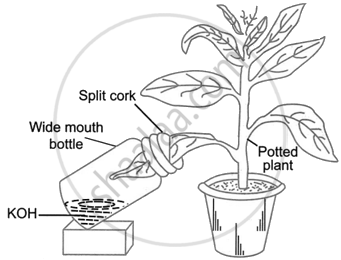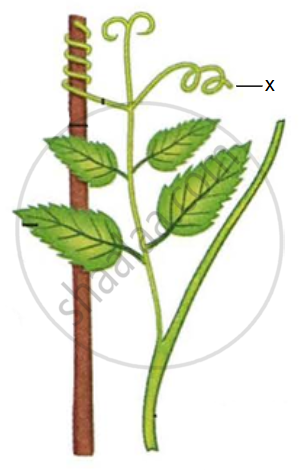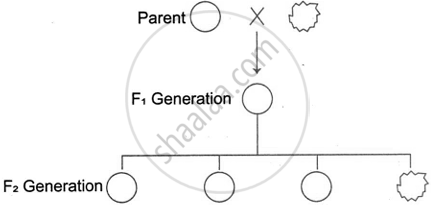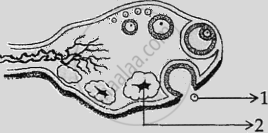(English Medium)
Academic Year: 2023-2024
Date & Time: 18th March 2024, 11:00 am
Duration: 2h
Advertisements
- Answers to this Paper must be written on the paper provided separately.
- You will not be allowed to write during the first 15 minutes.
- This time is to be spent reading the question paper.
- The time given at the head of this Paper is the time allowed for writing the answers.
- Section A is compulsory. Attempt any four questions from Section B.
- The intended marks for questions or parts of questions are given in brackets [ ].
Duplicated chromosomes are joined at a point termed ______.
Centrosome
Centromere
Centriole
Chromatid
Chapter: [0.012] Cell Cycle, Cell Division and Structure of Chromosomes [0.013000000000000001] Genetics – Some Basic Fundamentals
The process of conversion of ADP to ATP during photosynthesis is called ______.
Photolysis
Phagocytosis
Photophosphorylation
Polymerisation
Chapter: [0.023] Photosynthesis: Provider of Food for All
The process in which water is lost from the margins of strawberry leaves is ______.
Osmosis
Imbibition
Diffusion
Guttation
Chapter: [0.022000000000000002] Transpiration
The hormone that affects urination is ______.
Adrenaline
Vasopressin
Oestrogen
Thyroxine
Chapter: [0.034] The Endocrine System
Which one of the following helps in the opening of stomata?
Cobalt ions
Potassium ions
Magnesium ions
Aluminium ions
Chapter: [0.023] Photosynthesis: Provider of Food for All
A zygote which has Y chromosome inherited from the father will develop into a ______.
Will depend on the chromosome inherited from the mother
Girl
Either boy or a girl
Boy
Chapter: [0.013000000000000001] Genetics – Some Basic Fundamentals
The ear ossicle that transports sound vibrations to the inner ear:
Stapes
Malleus
Incus
Cochlea
Chapter: [0.033] Nervous System and Sense Organs [0.034] Sense Organs
If a person has a heart attack, what must be done immediately?
P. Loosen his/her clothing
Q. Make him/her lie down in an airy room
R. Rush him/her to the hospital
S. Engage him/her in a conversation
P and Q
P and S
R and S
P, Q and R
Chapter: [0.031] The Circulatory System
Adjusting the focal length of the eye lens to view objects at different distances is done by ______.
Cornea
Iris
Ciliary muscles
Sclera
Chapter: [0.033] Nervous System and Sense Organs [0.034] Sense Organs
Four friends P, Q, R and S were discussing the examples of genetic disorders. The examples they quoted were as follows:
P. Colour blindness and Malaria
Q. Albinism and Cholera
R. Haemophilia and Colour blindness
S. Haemophilia and Albinism
Who gave the correct examples?
P and Q
R and S
P and R
Q and S
Chapter: [0.013000000000000001] Genetics – Some Basic Fundamentals
Osmosis takes place when there is ______.
A freely permeable membrane
A cell wall
A selectively permeable membrane
An impermeable membrane
Chapter: [0.021] Absorption by Roots: The Processes Involved
A male gorilla has 48 chromosomes in each of its body cells. How many chromosomes will each of the sperms have?

24
48
17
16
Chapter: [0.012] Cell Cycle, Cell Division and Structure of Chromosomes [0.013000000000000001] Genetics – Some Basic Fundamentals
Assertion (A): Sympathetic nervous system prepares the body for violent action against abnormal conditions.
Reason (R): Sympathetic nervous system accelerates heartbeat.
Which of the following is correct?
Both A and R are True.
A is True, R is False.
A is False but R is True.
Both A and R are False.
Chapter: [0.033] Nervous System and Sense Organs
Birth rate is the number of live births per thousand persons in ______.
1 year
2 years
10 years
20 years
Chapter: [0.04] Population
Industrial melanism was observed in ______.
Mice
Peppered Moth
House Flies
Crow
Chapter: [0.05] Human Evolution
Name the following:
Unicellular outgrowths from the epidermis of roots.
Chapter: [0.021] Absorption by Roots: The Processes Involved
Name the following:
A defect in our eyes in which some parts of the object are in focus while the other parts are blurred.
Chapter: [0.033] Nervous System and Sense Organs [0.034] Sense Organs
Name the following:
The tropic movement of plant parts in response to chemicals.
Chapter: [0.024] Chemical Coordination in Plants
Name the following:
The main nitrogenous waste formed in the body.
Chapter: [0.032] The Excretory System (Elimination of Body Wastes)
Name the Following:
The process of attachment of fertilized ovum to the uterine wall.
Chapter: [0.035] The Reproductive System
Arrange and rewrite the terms in group in correct order to be in a logical sequence, beginning with the term that is underlined:
Australopithecus, Cro-Magnon, Homo erectus, Neanderthal man.
Chapter: [0.05] Human Evolution
Advertisements
Arrange and rewrite the term in group in correct order to be in a logical sequence, beginning with the term that is underlined:
Pupil, Aqueous humour, Retina, Vitreous humour.
Chapter: [0.033] Nervous System and Sense Organs [0.034] Sense Organs
Arrange and rewrite the terms in group in the correct order to be in a logical sequence, beginning with the term that is underlined:
Effector, Receptor, Motor neuron, Sensory neuron.
Chapter: [0.033] Nervous System and Sense Organs
Arrange and rewrite the terms in group in correct order to be in a logical sequence, beginning with the term that is underlined:
Loop of Henle, Distal convoluted tubule, Bowman's Capsule, Proximal convoluted tubule.
Chapter: [0.032] The Excretory System (Elimination of Body Wastes)
Arrange and rewrite the terms in group in correct order to be in a logical sequence, beginning with the term that is underlined:
Water vapour, Soil water, Leaves, Ascent of Sap.
Chapter: [0.021] Absorption by Roots: The Processes Involved
Study the diagram given below and fill in the blanks with suitable words:

In order to prove that carbon dioxide is necessary for
(a) ______, a potted plant is placed in dark for 48 hours to (b) ______ the leaves. A part of a leaf is inserted into a conical flask containing potassium hydroxide solution. This is to absorb (c) ______ from the flask. The plant is then placed in sunlight for a few hours. The experimental leaf is tested for starch. The part of the leaf that was inside the conical flask turns (d) ______, whereas the part of the left outside turns (e) ______ in colour.
Chapter: [0.023] Photosynthesis: Provider of Food for All [0.023] Photosynthesis: Provider of Food for All
Select the odd one from the following:
Prothrombin
Thrombin
Fibrinogen
Albumin
Chapter: [0.031] The Circulatory System
Choose the odd one out from the following terms and name the category to which the others belong:
Tonsils
Glomerulus
Spleen
Lymph nodes
Chapter: [0.031] The Circulatory System
Choose the odd one out from the following terms and name the category to which the others belong:
Neutrophils
Basophils
Monocytes
Eosinophils
Chapter: [0.031] The Circulatory System
Choose the odd one out from the following terms and name the category to which the others belong:
Leaves
Styrofoam
Grass
Cow Dung
Chapter: [0.06] Pollution
Choose the odd one out from the following terms and name the category to which the others belong:
Pulmonary artery
Renal artery
Coronary artery
Hepatic artery
Chapter: [0.031] The Circulatory System
Match the items given in Column I with the most appropriate ones in Column II and rewrite the correct matching pairs:
| Column I | Column II | ||
| (a) | Leydig Cells | 1. | Lack of thyroxine in children |
| (b) | Stoma | 2. | 12 pairs |
| (c) | Ova | 3. | Testosterone |
| (d) | Cranial nerve | 4. | Diffusion of respiratory gases |
| (e) | Cretinism | 5. | Haploid cells |
| 6. | 31 Pairs | ||
| 7. | Diploid cells |
Chapter: [0.035] The Reproductive System
Expand the abbreviation - NADP.
Chapter: [0.023] Photosynthesis: Provider of Food for All
Mention two adaptations in roots for absorption of water from the soil.
Chapter: [0.021] Absorption by Roots: The Processes Involved
Differentiate between Afferent arteriole and Efferent arteriole.
Chapter: [0.032] The Excretory System (Elimination of Body Wastes)
Give two examples of water pollutants.
Chapter: [0.06] Pollution
Ali has some pea plants in his garden which need a support to grow as seen in the picture given below:

- Name the phenomenon depicted by the shoot in the given figure.
- Define the above phenomenon.
- Write the name of the part marked X.
Chapter: [0.024] Chemical Coordination in Plants
Give the biological term for the surgical method of contraception in human females.
Chapter: [0.04] Population
State two harmful effects of acid rain on the environment.
Chapter: [0.06] Pollution
Enlist different advantages of transpiration.
Chapter: [0.022000000000000002] Transpiration
Write any two objectives of Swachh Bharat Abhiyan.
Chapter: [0.06] Pollution
Mohan is fond of playing basketball. His concentration is on shooting the ball into the opponent's basket as given in the picture.

- Which part of the brain helps Mohan to concentrate in putting the ball into the basket?
- Name the sense organ that helps to gauge the distance between the ball and the basket.
- Name the part of the brain that co-ordinates all the voluntary muscles of his body.
Chapter: [0.033] Nervous System and Sense Organs
Advertisements
Name the type of nerve which has the fibres of both sensory and motor neurons.
Chapter: [0.033] Nervous System and Sense Organs
Differentiate between Australopithecus and Modern man based on body hair.
Chapter: [0.05] Human Evolution
Give suitable biological reasons for the following statement:
The birth rate in India is very high.
Chapter: [0.04] Population
Give the exact location of the pericardium.
Chapter: [0.031] The Circulatory System
The exact location of the Bicuspid value
Chapter: [0.031] The Circulatory System
Given below is a schematic representation of the inheritance of the shape of the seeds of garden peas. Answer the questions that follow:

- Which is the dominant and recessive allele of the trait?
- What does the ratio 3 : 1 in the F2 generation represent?
- State Mendel's Law of Dominance.
Chapter: [0.013000000000000001] Genetics – Some Basic Fundamentals
Define the following term:
Diapedesis
Chapter: [0.031] The Circulatory System
Distinguish between Diabetes mellitus and Diabetes insipidus (endocrine gland concerned).
Chapter: [0.034] The Endocrine System
Give a scientific reason:
Carbon monoxide is highly dangerous when inhaled.
Chapter: [0.031] The Circulatory System
The diagram given below shows a section of the human ovary.

- Name the process for the release of the part labelled 1.
- Write the name of the structure marked 2.
Chapter: [0.035] The Reproductive System
Draw a neat, labelled diagram of a chloroplast.
Chapter: [0.023] Photosynthesis: Provider of Food for All
Define the following term:
Hormones
Chapter: [0.034] The Endocrine System
Which part of the human ear gives ‘Static balance’ to the body?
Chapter: [0.033] Nervous System and Sense Organs [0.034] Sense Organs
Which part of the human ear gives ‘ Dynamic balance’ to the body?
Chapter: [0.033] Nervous System and Sense Organs [0.034] Sense Organs
Describe the structural differences between an artery and a vein.
Chapter: [0.031] The Circulatory System
Write any two limitations of using a Ganong's potometer to demonstrate the uptake of water.
Chapter: [0.022000000000000002] Transpiration
A teacher drew the diagram of the heart on the blackboard and told the students to copy it in their notebooks. Mahesh couldn't see the diagram clearly as it appeared blurred to him.
- Name the defect of the eye Mahesh is suffering from.
- Where is the image formed in this defect?
- Mahesh consults an eye doctor and is prescribed suitable lenses to correct the defect. Which type of lens do his spectacles have?
Chapter: [0.033] Nervous System and Sense Organs [0.034] Sense Organs
Define the following term:
Ultrafiltration
Chapter: [0.032] The Excretory System (Elimination of Body Wastes)
Name the mineral elements required for the clotting of blood.
Chapter: [0.031] The Circulatory System
Name the mineral element required for the synthesis of thyroxine.
Chapter: [0.034] The Endocrine System
State any two harmful effects of noise pollution on human health.
Chapter: [0.06] Pollution
Why are RBCs efficient in their functions though they lack nucleus and mitochondria?
Chapter: [0.011000000000000001] Cell - the Structure and Fundamental Unit of Life [For Revision Only]
The diagram given below represents a stage in mitosis.

- Identify the stage given above.
- Give one reason to support your answer in (a).
- Mention the number of chromosomes given in the diagram.
Chapter: [0.012] Cell Cycle, Cell Division and Structure of Chromosomes
Other Solutions
Submit Question Paper
Help us maintain new question papers on Shaalaa.com, so we can continue to help studentsonly jpg, png and pdf files
CISCE previous year question papers ICSE Class 10 Biology with solutions 2023 - 2024
Previous year Question paper for CISCE ICSE Class 10 -2024 is solved by experts. Solved question papers gives you the chance to check yourself after your mock test.
By referring the question paper Solutions for Biology, you can scale your preparation level and work on your weak areas. It will also help the candidates in developing the time-management skills. Practice makes perfect, and there is no better way to practice than to attempt previous year question paper solutions of CISCE ICSE Class 10 .
How CISCE ICSE Class 10 Question Paper solutions Help Students ?
• Question paper solutions for Biology will helps students to prepare for exam.
• Question paper with answer will boost students confidence in exam time and also give you an idea About the important questions and topics to be prepared for the board exam.
• For finding solution of question papers no need to refer so multiple sources like textbook or guides.
